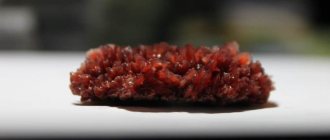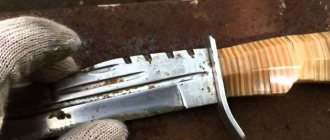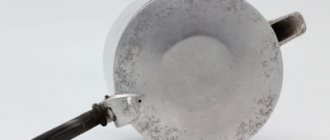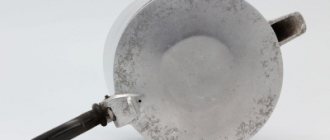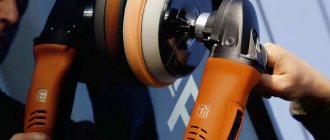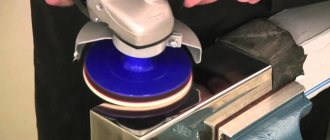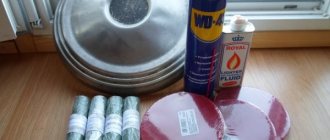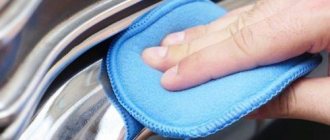Chemical polishing of aluminum
A metal product can be given shine in various ways. To do this, it is not necessary to use special coatings; you can use the polishing method.
It can be mechanical, for example, using sanding wheels, chemical - when the metal is immersed in a special solution, and also electrochemical. In this case, the effects of chemical components and electrical discharges are combined, which trigger certain reactions or enhance them.
Electrochemical polishing of metals can be performed in normal home conditions if you collect all the necessary equipment.
Process description
During electrochemical polishing, the treated metal surface acquires a mirror shine. Existing roughness is also reduced. The process goes like this:
- The part is considered an anode, that is, an electrode carrying a positive charge. It must be placed in a bath with a special composition.
- Another important component is the cathodes, which are necessary for the reaction to occur.
- As a result of exposure, a reaction occurs and dissolution occurs. It is uneven; first, the most noticeable roughness, which protrudes above the surface the most, is removed. At the same time, polishing occurs - the product acquires a mirror shine.
Removing noticeable large irregularities is called macropolishing, and smoothing out small defects is called micropolishing. If these processes occur simultaneously and evenly during processing, the product acquires shine and smoothness. It is also possible that shine will be obtained without smoothing or vice versa. The two types of polishing are not necessarily related.
Chemical polishing of metal results in the formation of a special film on the surface of the workpiece during the process. Its composition can be oxide or hydroxide. If it evenly covers the entire surface, this creates conditions for micropolishing. In this case, the outer part of the coating, located on the surface, continuously dissolves.
To be able to carry out micropolishing, it is necessary to ensure that a balance is maintained between continuous coating formation and dissolution; while working with the part, the layer thickness must remain unchanged.
This will allow the electrons of the metal being processed and the composition used to interact in the process without the danger of the metal product dissolving in an aggressive environment.
Macropolishing also directly depends on the film formed. It covers the product unevenly; on protruding irregularities this layer is thinner, so they dissolve faster due to the influence of current.
TIP: the effectiveness of the overall effect of the polishing composition can be increased if you use electrolytes for processing that contain salts of weakly dissociating acids, which increase the overall resistance of the coating.
In addition, the mechanical effect of mixing plays a role. The film thickness or diffuse layer may decrease. Some electrolytes used perform their function only when heated, and a general rule that applies to all compositions is that when heated, neutralization decreases and the rate of film dissolution increases.
Current density and voltage level are also among the factors that have a serious impact on the process. For example, if it is necessary to polish copper products, then a composition with phosphoric acid is selected for it and the maximum current mode is set without the formation of oxygen.
That is why it is important to strictly follow all the necessary parameters in order to achieve high-quality polishing.
Equipment and chemicals
To work with various metals, it is necessary to select the appropriate electrolytes that will help achieve the desired result:
- Most often, compositions based on various types of acid are used - sulfuric, phosphoric or chromic.
- Glycerin can be added to increase overall viscosity if required.
- Sulfureide acts as an etch inhibitor.
- To clean various products after the procedure, various solvents or alkaline agents can be used. Formulations with surfactant active ingredients are often used.
Proportions for creating a chemical composition
Polishing is carried out in special baths. It is important to remember that their components are toxic substances and hazardous to health, especially if heating is used, so all components must be handled with the utmost care, observing the required safety precautions.
Chemical and electrochemical polishing of metals
Electrochemical and chemical polishing is used both for decorative surface treatment after coating and during the processing of parts.
Electrochemical polishing
With electrochemical polishing, the surface microrelief is much smoother than with mechanical processing.
The coatings obtained by electrochemical polishing are non-porous and finely crystalline, which helps reduce the coefficient of friction and makes it possible to impart special optical properties to parts. During electrochemical polishing, the metal surface becomes shiny as a result of different rates of dissolution of microprotrusions and depressions.
The effect of electrochemical polishing is explained by the formation of a thin surface oxide film on the metal, which prevents etching. The thickness of the film is not the same on microprotrusions and microdepressions, as a result of which the solution during electrochemical polishing has a stronger effect on those areas where the film is thinner, i.e. on microprotrusions.
The quality of electrochemical polishing depends on the current density, electrolyte temperature, solution composition and electrolysis time.
The most widely used electrolytes based on phosphoric, sulfuric and chromic acids. To increase the viscosity of solutions, glycerin and methylcellulose are introduced. Sulfureide, triethanolamine, etc. are added to electrolytes for electrochemical polishing as etching inhibitors.
Chemical polishing
The chemical polishing method has much in common with the electrochemical polishing method. The appearance of shine on the surface of parts here, as with electrochemical polishing, is also associated with the presence of a thin film that prevents etching in the metal recesses.
The preferential dissolution of protrusions during chemical polishing is achieved both due to their increased chemical activity and due to the higher rate of diffusion of metal ions and fresh electrolyte.
Electrochemical polishing of steel parts.
Comparative characteristics of electrochemical and chemical polishing processes
The main advantages of the electrochemical polishing process are high productivity, good adhesion of galvanic coatings to the electropolished surface, and the ability to eliminate the degreasing operation necessary for mechanical polishing.
Electroplating
Metal products are often exposed to various harmful influences, losing their original appearance and technical characteristics. That is why galvanic coating is a relevant service. The processes are performed in approximately the following sequence:
- preparatory work - removing dirt, grease and mechanical processing products from surfaces
- machining – removing signs of wear by grinding and polishing (if necessary);
- washing with an organic solvent – to remove dirt and oil;
- degreasing;
- etching;
- coating;
- washing with water and alkaline solutions.
When applying various types of coatings, it is necessary to understand that there are various approaches and technological methods, the use of which allows you to obtain the required result and which should be taken into account in order to obtain high-quality and durable processing results with improved characteristics of the parts.
Preparatory processes should be carefully carried out, since the ease and efficiency of galvanization, as well as the service life of the surface, depend on them. For this reason, it is better to order work from specialized enterprises.
Classification of galvanic coatings.
For many years, galvanization has been a popular method for processing various metal products: equipment parts, jewelry and much more. To carry it out, special equipment is required that will allow for high-quality electroplating . In addition, it is better to entrust processes to competent specialists with experience in this activity - many enterprises cooperate with on an ongoing basis.
Source
Chemical and electrochemical polishing of metals
Electrochemical and chemical polishing is used both for decorative surface treatment after coating and during the processing of parts.
Compositions of electrolytes for chemical and electrochemical polishing of metals
Most electrolytes for electrochemical polishing of steel are based on mixtures of solutions of orthophosphoric and sulfuric acids with the addition of chromic anhydride.
Electrochemical polishing electrolyte containing 500–1100 g/l phosphoric acid, 250–550 g/l sulfuric acid and 30 g/l chromic anhydride is universal for electrochemical polishing of all types of steel, including 12Х18Н9Т. Electrochemical polishing mode: temperature 60–800C, current density 15–80 A/dm2, time 1–10 minutes.
For electrochemical polishing of steel 12Х18Н9Т it is possible to use electrolytes containing surfactants. Metal removal during electrochemical polishing occurs more intensively in the electrolyte: phosphoric acid 730 g/l, sulfuric acid - 580–725, triethanolamine 4–6 g/l, catapine 0.5–1.0 at 60–800C, current density 20–50 A /dm2, time 3–5 minutes.
Chemical polishing of steel , in contrast to electrochemical polishing, is used less frequently, although it is easier to use and has a number of advantages. The solution for chemical polishing of steel 12Х18Н9Т contains (g/l): sulfuric acid 620–630, nitric acid 60–70, hydrochloric acid 70–80, sodium chloride 1-12, acid black dye 3M 3–5. Temperature 70–750C, time 5–10 minutes.
For electrochemical polishing of copper and its alloys, solutions of phosphoric acid with chromic anhydride are used: phosphoric acid 850–900 g/l, chromic anhydride 100–150 g/l, temperature 30–400C, current density 20–50 A/dm2.
Chemical polishing of copper is carried out in a solution (g/l) of phosphoric acid 930–950, nitric acid 280–290 and acetic acid 230–260 at room temperature (as opposed to electrochemical) for 1–5 minutes.
Electrochemical polishing of aluminum and its alloys occurs when the rate of dissolution of the oxide film on the surface exceeds the rate of its formation.
The electrochemical polishing electrolyte contains a mixture of phosphoric acid (730–900 g/l), sulfuric acid (580–725 g/l) and surfactant (triethanolamine 4–6 g/l, catapin BPV 0.5–1.0 g/l).
Electrochemical polishing mode: temperature 60–800C, current density 10–50 A/dm2, time 3–5 minutes.
For electrochemical polishing of aluminum with high silicon content, the following composition (mass fractions) is recommended: hydrofluoric acid 0.13; glycerin 0.54; water 0.33. temperature 20–250C, current density 20 A/dm2, time 10–15 minutes.
Chemical polishing of aluminum wrought alloys is carried out in a solution of phosphoric acid 1500–1600 g/l with the addition of ammonium nitrate 85–100 g/l at 95–1000C for up to 5 minutes.
Electrochemical polishing of nickel is carried out in an electrolyte: 1000-1100 g/l of sulfuric acid at 20-300C and a current density of 20-40 A/dm2 for 2 minutes.
The quality of electrochemical and chemical polishing of parts, like all galvanic processes, depends on surface preparation (see “First steps in electroplating, part 2.”) and the accuracy of technological operations (composition of electrochemical polishing electrolyte, process modes).
When performing electrochemical and chemical polishing processes, safety precautions must be observed (see “Safe electroplating”).
For the development of new electrochemical technologies, please contact us.
Related publications:
- "Anodizing aluminum."
- "Decorative coatings."
Decorative etching.
Decorative etching is essentially a subtype of electropolishing - it is the anodic etching of aluminum alloys using a special mode in a phosphorus-chromium electrolyte. A crystalline pattern in the form of frost and rosettes is formed on aluminum. Parts hung on the anode rod begin to be processed at a voltage of 25-30 V (at the end of the process the voltage rises spontaneously to 35-40 V), the initial anode current density is 8-12 A/dm², and the temperature is 70-80°C. The pattern begins to emerge after 15-20 minutes. If the voltage begins to rise spontaneously, the process is over.
Upon completion of polishing, the product must be washed, dried, varnished or anodic oxidized and painted with organic paint.
There are other types of anodic etching of aluminum - “sparkling” (aluminum is subjected to thermal treatment according to a special scheme before and after the etching process), “snowball” (creating a matte-sparkling surface), and other types.
Chemical polishing of aluminum
A metal product can be given shine in various ways. To do this, it is not necessary to use special coatings; you can use the polishing method.
It can be mechanical, for example, using sanding wheels, chemical - when the metal is immersed in a special solution, and also electrochemical. In this case, the effects of chemical components and electrical discharges are combined, which trigger certain reactions or enhance them.
Electrochemical polishing of metals can be performed in normal home conditions if you collect all the necessary equipment.
Methods for polishing aluminum: chemical method
This technology is environmentally friendly, simple and quite fast.
It can be realized by having acid-resistant steel, which will form the basis of the polishing bath.
If the volume of work is relatively small, you can use porcelain crucibles. A solution of acids is poured into the container:
- sulfuric;
- nitrogen;
- orthophosphoric.
Effective ways to polish aluminum to a mirror finish
Polishing aluminum is designed to restore the smoothness of the coating and give the product its original mirror shine. There are various industrial and household technologies for eliminating surface defects on aluminum parts, including scratches, chips, and plaque. An effective way to restore the reflective effect of a coating at home is to use aluminum polishing paste.
Features of the material
Aluminum, as a metal with a soft structure, is characterized by susceptibility to external factors. Over time, the material darkens, its shine is lost, and its reflective effect decreases. During use, the surface becomes covered with scratches and a layer of plaque. To remove defects and restore the aesthetic appearance of the product, various means and technologies are used.
Ways and methods of polishing aluminum
To level out the roughness of the material and level out deep scratches in industrial conditions, complex technologies are used that involve working with chemical reagents. The process is performed using specialized equipment.
Electropolishing
This method involves restoring the coating and polishing aluminum to a mirror finish. The procedure involves processing the product in an electrolyte solution:
- the acid composition is heated in a special bath with an additional lead layer;
- lead cathodes are attached to aluminum;
- a current density of 10-50 A/dm² is passed.
Electropolishing of aluminum
The processing time is on average 5 minutes.
Chemical methods
The process of chemical polishing of aluminum is carried out using a special bath with a steel plate at the bottom:
- the tank is filled with a solution of sulfuric, nitric and phosphoric acids;
- the composition is heated to 90-120°C, depending on the composition of the material being processed;
- the aluminum product is immersed in an acidic environment for 30-45 seconds, then it must be rinsed with water;
- the processing algorithm is repeated 5-6 times;
- At the final stage, treatment is carried out with nitric acid 30%.
The electrochemical method of polishing aluminum involves the combined action of chemical reagents and electricity. In this case, the material being processed acts as an anode electrode, which is connected to a current source. The product is immersed in a reservoir with electrolyte, while the function of the second electrode is performed by copper cathodes.
Decorative etching
This technique for restoring aluminum products is a type of electropolishing. In this case, the workpiece is placed in a solution of phosphoric and chromic acids and exposed to anodes.
The electrical voltage increases from 25 V to 40 V, and the ambient temperature during the process changes from 50°C to 80°C. As a result of processing within 15-20 minutes, the surface of the aluminum is covered with a chaotic pattern.
Next, the product is thoroughly washed under running water, dried and painted with a special paint for organics.
Polishing aluminum at home
To restore the characteristic shine of an aluminum surface at home, various folk methods and household chemicals are used.
Tools and devices
What you need to have on hand to get rid of scratches and dullness, and restore the original aesthetics of objects: for this, use a special paste for polishing aluminum. You can also deal with the problem using a number of common cleaning products and kitchen products, including:
- soap solution;
- glass and porcelain cleaning products;
- cream of tartar, table vinegar;
- baking soda, salt, lemon, alcohol;
- sorrel, sour apple, kefir.
In addition, you will need the following set of tools for polishing aluminum:
- fine and medium grit sandpaper;
- felt-coated polishing discs;
- metal brush;
- rags.
When choosing products and devices for polishing aluminum products at home, you should take into account the composition and characteristics of the material being processed. Food-grade aluminum should not be polished with abrasives; gentle methods for eliminating defects are appropriate here.
Pre-cleaning
If you plan to work with a painted part, at the initial stage of the procedure it is necessary to carry out preliminary cleaning, remove coating residues and oxidation particles. For this, various solvents and abrasives are used.
Tartar polishing
Cream of tartar solution copes well with darkening and deposits on metal:
- dissolve cream of tartar in a container of hot water, add lemon juice and bring to a boil;
- moisten a soft cloth in the cooled solution and wipe aluminum objects to a mirror shine.
Aluminum polishing can be done with cream of tartar
If cream of tartar is diluted with a small amount of water to a paste-like consistency, you can obtain an effective remedy for soot, oxidation and various contaminants on metal products.
Application of polish
As a special product for the care of aluminum products, polish has a number of advantages:
- helps quickly eliminate scratches and other visual defects;
- allows you to polish the aluminum surface to a mirror shine;
- does not contain ammonia and other aggressive substances;
- forms a protective layer, provides a barrier against oxidation.
Paste for polishing aluminum in Moscow and other regions is presented in a wide variety of products.
The nuances of using polish:
- The surface is pre-cleaned of paint coatings and dirt using a metal brush.
- Alternately, roughness is eliminated using medium and fine grain abrasives.
- After grinding, a paste is applied to the aluminum and rubbed in a circular motion using a rag until it has a reflective effect.
- Remains of the product are removed with a clean napkin.
To increase resistance to minor scratches and dirt, the surface is varnished after polishing.
Traditional methods of cleaning and polishing aluminum products
To give a shiny look to household items and decorative elements, use various recipes with simple and inexpensive ingredients.
Sour apple
To clean the container from carbon deposits, you need to cut the apple in half and rub the surface well with the half. The acid in the fruit helps to quickly remove soot.
Kefir or cucumber pickle
To combat dark spots, leave the dishes with brine or kefir inside for 12 hours. Next, you need to wash the product in warm water with a soft cloth.
Baking soda
Dilute soda with water to a paste consistency, which is applied to the metal and wiped with a sponge. This method will help to clean the product from plaque and dirt, and polish it to a shine.
Baking Soda - Aluminum Polish
Ammonia and borax
A homemade polishing mixture of borax (15 g) and ammonia (5 g) allows you to restore the beauty of the product and give the thing a mirror-like shine. The composition is applied with a sponge and rubbed well, then rinsed under running water.
The nuances of polishing aluminum sheet products
Leveling the surface and eliminating scratches on sheet metal is done using a polishing machine. Sequence of work:
- Preparatory stage. The surface is cleaned of paint, dirt and oxide using a metal brush. Use a soft cloth to remove residues and dust deposits;
- Grinding. Medium-grained abrasives correct visual defects, roughness, and deep scratches. Next, using fine sandpaper, level the surfaces to a perfectly smooth state.
The grinding machine allows you to process aluminum to an exceptional shine. The polishing wheel of the device is equipped with various types of attachments depending on the nature of the work and the characteristics of the material.
The nuances of working with a grinding unit:
- the polishing wheel, like the sheet of metal being processed, is moistened with water;
- as a result of friction, heating of the metal plane is observed, under the influence of the rotating circle, roughness is eliminated, small particles of metal and water are formed in the form of a slurry;
- regularly, at intervals of 1-2 minutes, turn off the device, rinse the polishing disc under running water, wash off particles of formations on the metal sheet;
- After leveling visual defects with the help of abrasives, the grinding machine wheel is equipped with a felt attachment and final polishing of the aluminum is performed.
The procedure is completed by treating the surface with a polishing paste, which promotes the formation of a coating with a mirror effect.
Polishing Safety Recommendations and Warnings
Procedures using electropolishing or chemical methods to restore the visual characteristics of aluminum are highly effective.
They allow you to quickly achieve a mirror-like shine on a metal surface. However, it is not safe to use these industrial technologies at home.
To polish aluminum products yourself, it is better to use felt wheels, special pastes and folk remedies.
How does the electropolishing process work?
A metal plate is connected to the cathode (-), and the workpiece is connected to the anode (+). The DC power supply creates a low voltage in the acid bath. An electrochemical reaction occurs that causes etching of the metal at the anode. The electric charge is increased on the protrusions - this is how burrs are removed. Electropolishing kills bacteria and improves the corrosion resistance of metal.
The best results are obtained with the correct ratios of voltage density, current density and the use of an effective electrolyte.
Example: electropolished pipes in a dairy plant make it possible to extend the shelf life of the final product because the amount of bacteria and harmful substances in the milk that cause it to sour is reduced.
You can find detailed information about the electropolishing method in a large article in the “Blog” section: “Electropolishing Technology”.
Do-it-yourself aluminum polishing: methods, means, devices
Aluminum is a fairly soft metal. Any product made from it loses its original appearance over time, abrasions and oxides appear on the surface, and the product becomes dull. If you want to give an old item a new look, you should polish the aluminum. To do this, you can use one of the following methods:
- electropolishing;
- chemical polishing;
- decorative etching.
Additional recommendations for work
Polishing of aluminum can be carried out using alkali solutions:
- trisodium phosphate;
- sodium nitrate;
- caustic soda;
- sodium nitrate.
Their temperature should be higher compared to the acid method, the limit is 120-140 °C. The products need to be held for approximately 5-20 seconds. When this technique is used, the aluminum loss will be approximately 8 µm of the total layer thickness.
Use of electropolishing
Polishing aluminum can be done in another way. In this case, it is possible to obtain a sparkling and smooth surface, and cleaning is characterized by high quality. Electrolytes for such work in most cases contain sulfuric and phosphoric acid; the remaining components will depend on the material.
Electrolytes allow you to achieve shine after completion of work. For the process, the temperature must be lower than in the case described above; the temperature limit will be from 60 to 90 °C.
Polishing must be carried out for 5 minutes, while the current density can be 10-50 A/dm².
The polishing process involves the use of lead cathodes, but there are other alloys that require the use of stainless steel.
Polishing requires the use of duralumin pendants, as well as electrolyte baths with polyethylene, lead or fluoroplastic treatment. You need to prepare alkaline electrolytes, they will cost less.
The process parameters will be influenced by the composition of the electrolyte, the temperature limit can vary from 40 to 95 °C, as for the exposure, it lasts from 3 to 6 minutes, while the current density at the anode is a limit of 3-20 A/dm². When choosing cathodes, you should prefer nickel-plated ones.
Features of decorative etching
Polishing of aluminum can be done in a decorative way. This technique acts as a subtype of electropolishing. Aluminum alloys are etched by anodes according to the regime in a phosphorus-chromium electrolyte.
A crystalline pattern is formed on the surface of the products, which looks like rosettes or frost. All parts are hung on the anode rod, and then processing can begin. Manipulations should be carried out at a voltage of 25-30 V.
By the end, the voltage will rise to 35-40 V, the anode current density will be equal to the limit of 8-12 A/dm², while the temperature will vary from 50 to 80 °C.
After about 20 minutes the drawing will appear. If the voltage begins to rise arbitrarily, then the process can be considered complete. After completing the manipulations, the products are washed, dried well, and anodic oxidation is carried out on them. The aluminum is then painted with organic paint.
The mirror-like shine of aluminum can be obtained by another method of anodic etching, which is called sparking. For this purpose, before and after the process, the products are subjected to heat treatment according to a special scheme. You can use anodic etching “snowball”, which allows you to create a matte-sparkling surface.
Which method is better to use at home?
Polishing paste is one of the most commonly used aluminum polishing products at home. This is due to the fact that the chemical compounds are toxic and dangerous to human health. For polishing you can use:
- sandpaper;
- hard brushes;
- varnish;
- rags;
- alcohol-type cleaning products.
When choosing sandpaper, it is important not to overdo it with the grain size, otherwise you will have to remove scratches. To increase wear resistance and add shine, it is better to use varnish.
Features of electrochemical polishing
Electrochemical polishing of aluminum involves the implementation of work using the method of parallel chemical and electrical influences.
According to the technology of this method, the part acts as an anode electrode, and a positive current source is connected to it.
The workpiece with current supplied to it must be immersed in a reservoir, which is filled with electrolyte. Copper cathodes act as the second electrode.
Using a polisher
A polishing machine is a very convenient tool for giving aluminum its original shine. To do this, you can use a 1000 polishing wheel, which is wetted with water. Use a sponge or rag to apply water to the area to be treated. Next, the polishing machine is turned on at 1400 rpm. At this speed, the spray will scatter 1 m around.
The surface of the aluminum will begin to heat up, the liquid will evaporate. You must be prepared for the circle to become clogged with aluminum “porridge”. Therefore, the machine should be stopped every minute to rinse the abrasive wheel with a wet sponge under running water. To do this, some craftsmen use a regular spray bottle.
The “porridge” should also be removed from the part. You will get a mirror shine if you additionally use felt. This stage is one of the most important. 80% of the final result will depend on it.
The felt should protrude 10 mm beyond the base; the circle should be moistened by spraying it with a spray bottle. The part is wetted with a damp sponge. The polishing paste used is coarse; it should be applied to the part, not to the wheel.
Conclusion
Polishing aluminum with your own hands can be done using different means, but one of the most effective is paste. It does not contain ammonia additives and is able to gently clean the part from roughness and scratches. With this composition you can achieve the original shine. The protective layer will prevent the occurrence of oxidation over a long period.
Electropolishing.
Achieving a smooth and sparkling surface, high-quality cleaning – this is what characterizes aluminum polishing using electricity. Most electrolytes for electrochemical polishing of aluminum are based on orthophosphoric and sulfuric acid; the remaining components depend on the aluminum alloy. Such electrolytes give a good shine after polishing. The temperature required for the electropolishing process of aluminum is lower than for chemical polishing - about 60-90°C. Polishing time – 3-5 minutes, current density – 10-50 A/dm². In the electropolishing process, lead cathodes are used (for some alloys, stainless steel), duralumin pendants, and electrolyte baths with lead, polyethylene, or fluoroplastic treatment.
Alkaline electrolytes are also used. They are simpler and cheaper; the electrolyte compositions are based on trisodium phosphates, hexamethophosphates, soda ash or caustic soda. The process parameters depend on the composition of the electrolyte and range from: process temperature - 40-80-95°C, current density at the anode 3-20 A/dm², holding time 3-6 minutes. Cathodes must be nickel plated.
Electrochemical polishing of steel
Aluminum is a fairly light and durable metal, and therefore is often used in the kitchen as the main material from which cookware is made. When plaque appears, it becomes unpleasant to cook in it, and it is impossible for safety reasons, and therefore the question arises of how to clean aluminum until it shines.
Cleaning features, general recommendations
Heating of aluminum cookware occurs evenly and does not require much time. After some time, carbon deposits begin to appear on aluminum cookware and traces of oxide become noticeable. Most often, they try to clean aluminum using dishwashing detergent, but it can only remove external dirt and grease.
Dishes made from this material should only be washed cold, since they can easily be damaged when hot. If a hot metal is immersed in cold water, it will become deformed, and therefore you should try to avoid such a failure.
You should not try to clean burnt food immediately using iron sponges and other objects. To make the task easier, you just need to pour warm water and wait about half an hour. During this time, the food will get wet and can be removed using a regular dishwashing sponge.
It is not recommended to wash aluminum cookware in the dishwasher, since the dishwasher uses hot water during the washing process, which can damage the material. To avoid deformation, it is recommended to wash aluminum cookware by hand with warm water.
You should not use strong acids in the process, as they will not be able to restore the shine of the dishes, and may harm them. It is also not recommended to clean it with metal sponges, which leave scratches on the dishes.
Chemical polishing
Fast, simple, economical - this is how you can characterize this method of polishing small aluminum parts.
A solution of acids (orthophosphoric, sulfuric, nitric) with special additives is poured into a polishing bath made of acid-resistant steel (if the volumes are small - porcelain crucibles).
The parts are immersed in a hot solution (the solution temperature is high - 90-120°C - depending on the type of aluminum) for half a minute to a minute 5-6 times. In the intervals between dives, the parts are washed in a catcher, constantly shaking them.
Better polishing is obtained in a drum rotating at a certain speed. Parts with complex profiles are polished in a solution with a greater degree of preliminary use.
After chemical polishing, a film of contact copper remains on the product. To remove it, the products are washed under low-temperature running water in a trap and treated with 30% nitric acid.
Also, when chemically polishing aluminum, alkali solutions are used (trisodium phosphate, caustic soda, sodium nitrate, sodium nitrate). Alkaline solutions should have a higher temperature than acid solutions and may be 120-140°C. Exposure in solutions ranges from 5 to 20 s. During chemical polishing, the loss of aluminum is about 7-8 microns of the layer thickness.
Cleaning aluminum cookware
The main disadvantage of aluminum is its softness. It is very easy to damage and also leave scratches on it. Even with frequent washing with a melamine sponge, the surface will soon begin to become matte, as a large number of micro-scratches will remain on it.
- To restore shine, you need to use borax, ammonia and GOI paste. The latter needs to thoroughly rub the aluminum, and then, using a rag soaked in solvent, thoroughly rub the cutlery.
- Aluminum cookware can be cleaned with such products as soap, ammonia, table vinegar and table salt.
- Soot, oxide and other contaminants that accumulate on aluminum cookware can be easily removed using soft foam sponges or polymer bristles, microfiber or cotton cloths, and rags. It is necessary to ensure that they do not contain rougher and harder materials that can leave scratches.
- A good aluminum cleaner is a special product designed for cleaning glass or porcelain. They do an excellent job, gently removing dirt and adding shine to the dishes.
We also recommend reading: Order food online: how good are food delivery services?

